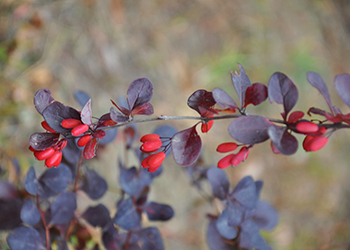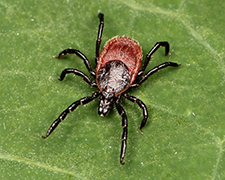A Japanese Barberry and Lyme
A Japanese Barberry and Lyme
Site Ecology Team (SET) and Wildlife and Industry Together (WAIT)
November 5, 2015

I’m sorry, that’s not something we serve here. You might try a Nursery.
It does sound like a soothing and refreshing drink, but not in this case.
Many of us have or know someone who has Japanese Barberry plants (Berberrus thumbergii) growing on their property. They were introduced into New England in 1875 and not considered a problem plant until the 1980s. Now they are showing up on Invasive Plant Lists in many states. New Jersey is hardest hit with plants reaching into the tree canopy. They were very popular in the nursery trade because of their hardiness and minimal care requirements. You could literally “dig a hole and drop them in”. They came in a variety of colors, shapes, and sizes (45+ cultivars). Their thorns made them a formable hedge or barrier and they were deer proof.
However, they may come with or have a hidden secret. They can spread easily by land, air and water, plus seed have high viability. Yes, you may be getting more than you bargained for with this plant. The title may have given the secret away. It’s growth characteristic forms a micro niche that we all should be aware of if we have these bushes, have children, and spend time outside.



These creatures are not all the same size. The pictures are NOT to the same scale.
The “Circle of Life” includes the barberry, the white-footed deer mouse, the black-legged tick, the whitetailed deer, and possibly humans. The bushes themselves can create a moist, cool leafy shelter - “tick nursery” that favors the tick nymph and adult, and the white-footed mouse. These become part of the tick lifecycle. The adult ticks transfer to the white-tailed deer and are spread to locations frequented by humans. Field studies at the University of Connecticut Research Forest have shown a significant change in tick concentration when barberry plants and deer are in the area.
The barberry, while modifying the above ground environment, can also change the soil chemistry, texture, and microbes. Leaf litter from the barberry decomposes faster than our usual forest litter, due in part to the elevated amount of alkaloids and nitrogen-rich compounds. The resulting increase in nitrates contributes to eliminating native species that can’t tolerate the soil changes. Adding a small inoculate from the barberry soil to “normal” forest litter soil, increases the rate of decomposition. A little bit goes a long way. Once the soil is transformed by the presence of the barberry it’s nearly impossible to reverse. Plants that are planted where barberry plants once grew, don’t usually do well.
The next time you get stuck by a barberry, you might not realize just how many places you did get stuck. This plant has turned into a menace, not a friend to the environment or to pets or humans.
Do pets or family get tick bites beginning in the spring?
Solutions
- Encourage use of native species
- Remove plant material even fallen leaves, the compost pile is not where you want it to go
- Remove seedlings especially those away from the main plant
- Check plants for ticks and make a critical decision
Sources



